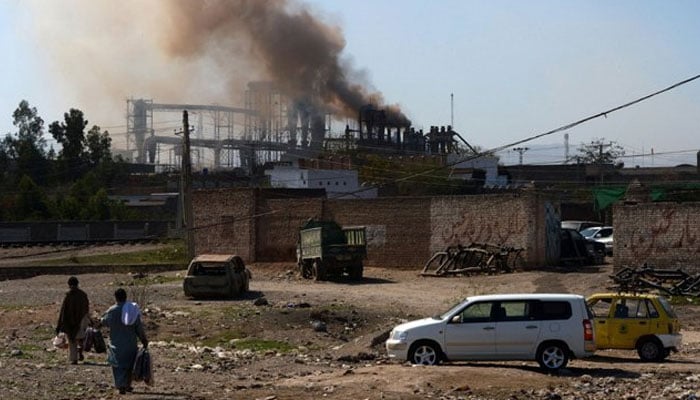High levels of air pollution in Peshawar reducing age by 2 to 3 years
The PCAA study finds that annually PM2.5 (particulate matter) in Peshawar has ranged between 61.40 µg/m3 and 80.09 µg/m3, exceeding the current national and provincial standards by 4-5 times
PESHAWAR: A new study has found that Peshawar city faces high levels of air pollution. The air pollution levels, particularly, in the winter months place the city among the world’s most polluted cities. In terms of health impact, it affects at least five million people, increasing public health costs and reducing human development achievement.
The age of city dwellers is decreasing by at least two to three years because of high levels of air pollution. Low interest is behind lack of capacity for monitoring air pollution.
This Status of Air Pollution in Peshawar (SAPP) report has been produced by the Peshawar Clean Air Alliance (PCAA). The PCAA is a civil society-led network of stakeholders formed under the Foreign, Commonwealth & Development Office, UK (FCDO) funded Sustainable Energy and Economic Development (SEED) Programme for the government of Khyber Pakhtunkhwa being executed by Adam Smith International (ASI).
The PCAA study finds that annually PM2.5 (particulate matter) in Peshawar has ranged between 61.40 µg/m3 and 80.09 µg/m3, exceeding the current national and provincial standards by 4-5 times, and the WHO air quality guidelines by 12-16 times. High levels of PM2.5 have considerable health impacts on the population of Peshawar. The city does not have an effective air quality monitoring network, run by the regulator, which has created this blind spot. Based on provincial petroleum supply data, it is estimated that the Peshawar region consumed approximately 794,642 tons of petroleum fuel products during 2020-21.
The report revealed that the major sources of pollution are transport, industry, domestic solid-fuel usage, municipal waste burning, and dust. Between 2012 and 2020, the number of registered vehicles in Peshawar rose by 85%, while the largest increase (168.8%) is noted in motorbikes. The vehicle figures are likely underestimated, as a significant number of vehicles plying on the roads are registered in Islamabad and other cities.
“Peshawar also has the highest concentration of industry in the province and generates the most solid waste. Consumption of various fossil fuels across these sectors and burning activity are the drivers of air pollution in the city. Among these sources, transport emissions contribute more than half (58.46%), followed by dust, domestic sector, industry, waste-burning, and lastly commercial activity,” the report said
The report says the Peshawar district covers an area of 1,518 kms and is home to approximately 5 million people; among them, nearly half reside in the urban areas of Peshawar city. The Air-Quality Life Index (AQLI) estimates that citizens of Peshawar can add up to 2.3 years to their life expectancy if PM2.5 levels meet the World Health Organisation (WHO) guidelines. Turning this estimate around, this also means that currently, they are losing these years because of high levels of air pollution.
An emissions inventory of a region is a comprehensive breakdown of the total pollutants in the air, on the basis of various combustion activities. The inventory aims to report five key air pollutants, namely Oxides of Nitrogen (NOX), Sulphur Dioxide (SO2), Carbon Monoxide (CO), Particulate Matter (PM), and Non-methane Volatile Organic Compounds (NMVOCs).
The transport sector emits pollution both due to the use poor quality of fuel available in retail as well as the absolute number of vehicles on the roads. Motor vehicles undergo significant wear-and-tear over their operational life and release particulate, particularly through brake pads and reduced engine efficiency. Separately, lead in gasoline and Sulphur in high-speed diesel result in particulate matter emissions. Due to the very high percentage of Sulphur (0.5-1%) in diesel, and the non-availability of Euro-5 emissions compliant diesel engines, it is not possible to implement diesel particulate filters (DPFs). Some proportion of commercial and industrial sector emissions are also likely to be linked to fuel quality, as energy generation through furnace oil boilers and diesel generators produce particulate which cannot be mitigated effectively with filtering.
In the course of the study, it is also determined that a significant concern is biomass burning, both in the form of open waste-burning as well as fuel in households. Wood-burning is prevalent in rural areas, but also in use in many urban households. This is likely to be the biggest cause of Household Air Pollution (HAP), which is known to be specifically detrimental to the health of women who are exposed to fumes and particulate during activities such as cooking and heating.
The study recommended expanding monitoring capacity to increase public awareness and enable precautionary measures, encourage higher public transport usage, and develop alternative and subsidised heating methods to curtail wood-burning.
This study proposes the development of a Peshawar Air Quality Management Plan. The primary challenges in the city are related to the emissions from the transport and domestic sector, while certain industries require mitigation as well, particularly kilns and furnaces.
It is pertinent to mention here that the Peshawar has been declared as the third most polluted city in Pakistan and the ninth most polluted in the world, in the 2021 World Air Quality report. Over the past decade, air quality has deteriorated, which is consistent with observations in other major urban centres in Pakistan.
-
 First Poll Since King Charles' Action Against Andrew Reveals Royal Family's Public Standing
First Poll Since King Charles' Action Against Andrew Reveals Royal Family's Public Standing -
 Blake Lively Strengthens Legal Team Ahead Of Justin Baldoni Trial
Blake Lively Strengthens Legal Team Ahead Of Justin Baldoni Trial -
 'Back To School!': Palace Shares Details Of Princess Anne's Latest Engagements
'Back To School!': Palace Shares Details Of Princess Anne's Latest Engagements -
 Paul Mescal Clarifies Acting Break Comment As He Teases Paul McCartney Role
Paul Mescal Clarifies Acting Break Comment As He Teases Paul McCartney Role -
 Kate Middleton's Unexpected Style Of Arrival At Solo Outing Goes Viral
Kate Middleton's Unexpected Style Of Arrival At Solo Outing Goes Viral -
 Why ‘X’ Is Down? Thousands Report Twitter Outage: Here’s What You Can Do
Why ‘X’ Is Down? Thousands Report Twitter Outage: Here’s What You Can Do -
 Florida Man Held After Alleged Nail-scattering On Busy Intersections
Florida Man Held After Alleged Nail-scattering On Busy Intersections -
 Valeria Nicov: Sean Penn's Athletic Girlfriend Raises Eyebrows With Latest Photos
Valeria Nicov: Sean Penn's Athletic Girlfriend Raises Eyebrows With Latest Photos -
 Sharon Stone Lashes Out At Fellow Award Show Attendees After Stealing Accusations
Sharon Stone Lashes Out At Fellow Award Show Attendees After Stealing Accusations -
 Gwyneth Paltrow Reveals Real Reason She Said Yes To 'Marty Supreme'
Gwyneth Paltrow Reveals Real Reason She Said Yes To 'Marty Supreme' -
 King Charles Says He And Queen Camilla Stand With People Of Ukraine
King Charles Says He And Queen Camilla Stand With People Of Ukraine -
 Ben Affleck Argues In Favour Of His Shirtless Scene In 'The Rip'
Ben Affleck Argues In Favour Of His Shirtless Scene In 'The Rip' -
 Mississippi Postal Worker Arrested After Complaints Of Marijuana Odour In Letters
Mississippi Postal Worker Arrested After Complaints Of Marijuana Odour In Letters -
 Canada, China Lock Initial Trade Deal On ‘EV,Canola’ To Strengthen Ties: What To Expect Next?
Canada, China Lock Initial Trade Deal On ‘EV,Canola’ To Strengthen Ties: What To Expect Next? -
 Melissa Leo On Euphoria Of Winning An Oscar Vs It's Impact On Career
Melissa Leo On Euphoria Of Winning An Oscar Vs It's Impact On Career -
 Meghan Markle, Prince Harry Express 'hope' In Latest Major Statement
Meghan Markle, Prince Harry Express 'hope' In Latest Major Statement




